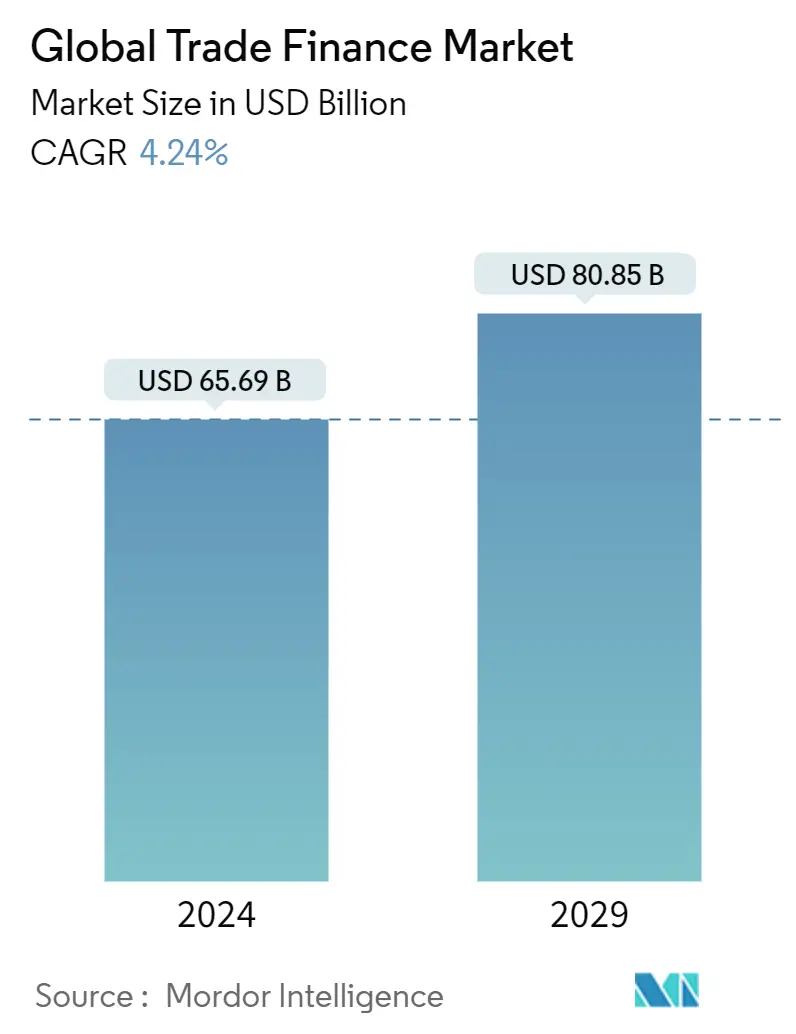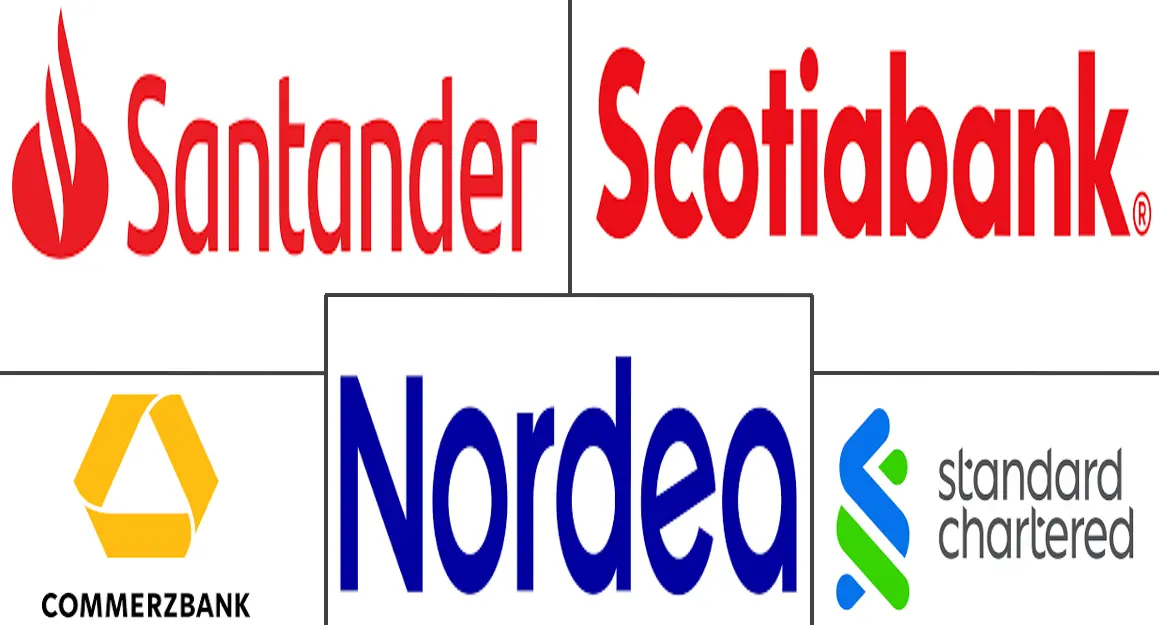Market Size of Global Trade Finance Industry

| Study Period | 2020 - 2029 |
| Market Size (2024) | USD 65.69 Billion |
| Market Size (2029) | USD 80.85 Billion |
| CAGR (2024 - 2029) | 4.24 % |
| Fastest Growing Market | Asia-Pacific |
| Largest Market | Europe |
Major Players
*Disclaimer: Major Players sorted in no particular order |
Trade Finance Market Analysis
The Global Trade Finance Market size is estimated at USD 65.69 billion in 2024, and is expected to reach USD 80.85 billion by 2029, growing at a CAGR of 4.24% during the forecast period (2024-2029).
SMEs' adoption of trade finance in developing countries increased due to the need to ensure smooth trading activities. Factors like increased competition and new trade agreements are supporting the trade finance market growth. The surge of trade wars and high-cost implementation also supports the market's development. Since the trade finance industry integrates with blockchain technology, it provides opportunities for the global market to expand.
The emerging trend of sustainable finance in the trade finance industry is the growing element of environmental, social, and governance (ESG) principles. Businesses and financial institutions are highly incorporating sustainability in trade finance decisions. The popular sustainable trade finance instruments are green bonds and ESG-linked loans. The integration of sustainable finance practices in the trade finance industry became popular due to the rising awareness about climate and social issues.
The rapid growth of advanced technology and digitalization supports the global market's growth. Traditional paper-based processes gave way to digital solutions. Blockchain technology introduced transparency and security into supply chain finance and trade settlements to reduce fraud and errors. To enhance risk assessment and make more accurate credit decisions for facilitating the financing gap for small and medium-sized enterprises (SMEs), artificial intelligence (AI) technology and data analytics were introduced. Fintech start-ups raised innovative digital platforms to make them more accessible and affordable.
Trade Finance Indsutry Segmentation
International trade flows are funded by trade finance. In order to mitigate risks related to transactions and increase the efficiency of working capital for enterprises, trade finance acts as a facilitator among importers and exporters. Activities such as funding trade at home and abroad are covered. The market for trade finance is divided by service providers and geography. Service providers segment the market into banks, trade finance, and insurance companies. The market is segmented by geography into North America, Europe, the Middle East, South America, and Asia-Pacific. The market report offers market size and forecasts for the trade finance market in value (USD) for all the above segments.
| By Service Provider | |
| Banks | |
| Trade Finance Companies | |
| Insurance Companies |
| By Geography | ||||||||
| ||||||||
| ||||||||
| ||||||||
| ||||||||
|
Global Trade Finance Market Size Summary
The trade finance market is experiencing significant growth, driven by the increasing adoption of trade finance solutions by SMEs in developing countries and the integration of advanced technologies like blockchain and AI. The market is benefiting from the rise in globalization and the expanding volume of international trade, which necessitates efficient and secure financing solutions for cross-border transactions. The shift from traditional paper-based processes to digital solutions has introduced greater transparency and security in supply chain finance, reducing fraud and errors. Additionally, the emergence of fintech startups has made trade finance services more accessible and affordable, further supporting market expansion.
North America stands out as a key region in the trade finance market, supported by its robust financial infrastructure and well-established banking institutions. The region's businesses are increasingly adopting trade finance instruments to facilitate trade both within the region and with global partners. The integration of sustainable finance practices, including ESG principles, is also gaining traction in North America, contributing to market growth. The competitive landscape is marked by the rapid adoption of technologies such as machine learning and IoT, with major players like Santander Bank, Scotiabank, Commerzbank, Nordea Group, and Standard Chartered Bank focusing on product development to enhance their geographical presence and compete effectively.
Global Trade Finance Market Size - Table of Contents
-
1. MARKET INSIGHTS AND DYNAMICS
-
1.1 Market Overview
-
1.2 Market Drivers
-
1.2.1 Rise In Global Trade Drives The Market
-
1.2.2 Increasing Investments And Innovations In Fintech Drives The Market
-
-
1.3 Market Restraints
-
1.3.1 Risk Concerns on Uncertainty With Respect To Investments Which Negatively Impacts On Financial Welfare
-
1.3.2 Complexities In Trade Finance Transactions
-
1.3.2.1
-
-
1.3.3 Market Opportunities
-
1.3.3.1 Technological Advancements In Trade Finance Market
-
-
-
1.4 Industry Value Chain Analysis
-
1.5 Industry Attractiveness: Porter's Five Forces Analysis
-
1.5.1 Threat of New Entrants
-
1.5.2 Bargaining Power of Buyers
-
1.5.3 Bargaining Power of Suppliers
-
1.5.4 Threat of Substitutes
-
1.5.5 Intensity of Competitive Rivalry
-
-
1.6 Insights On Technology Innovation In The Market.
-
1.7 Impact of COVID-19 on the Market
-
-
2. MARKET SEGMENTATION
-
2.1 By Service Provider
-
2.1.1 Banks
-
2.1.2 Trade Finance Companies
-
2.1.3 Insurance Companies
-
-
2.2 By Geography
-
2.2.1 North America
-
2.2.1.1 US
-
2.2.1.2 Canada
-
2.2.1.3 Mexico
-
2.2.1.4 Rest of North America
-
-
2.2.2 Europe
-
2.2.2.1 Germany
-
2.2.2.2 UK
-
2.2.2.3 France
-
2.2.2.4 Russia
-
2.2.2.5 Spain
-
2.2.2.6 Rest of Europe
-
-
2.2.3 Asia-Pacific
-
2.2.3.1 India
-
2.2.3.2 China
-
2.2.3.3 Japan
-
2.2.3.4 Rest of Asia-Pacific
-
-
2.2.4 South America
-
2.2.4.1 Brazil
-
2.2.4.2 Argentina
-
-
2.2.5 Middle East And Africa
-
2.2.5.1 UAE
-
2.2.5.2 Saudi Arabia
-
2.2.5.3 Rest of Middle East And Africa
-
-
-
Global Trade Finance Market Size FAQs
How big is the Global Trade Finance Market?
The Global Trade Finance Market size is expected to reach USD 65.69 billion in 2024 and grow at a CAGR of 4.24% to reach USD 80.85 billion by 2029.
What is the current Global Trade Finance Market size?
In 2024, the Global Trade Finance Market size is expected to reach USD 65.69 billion.

